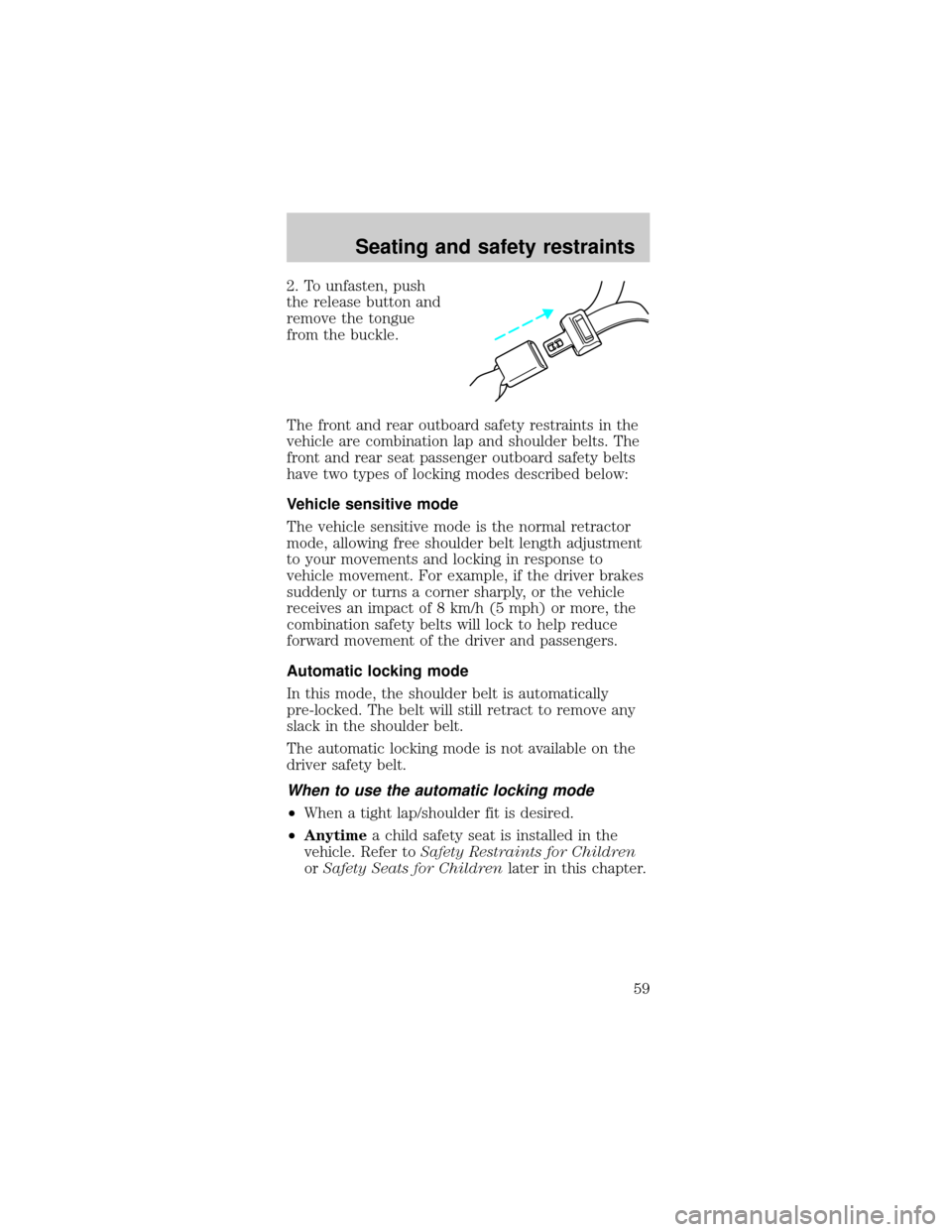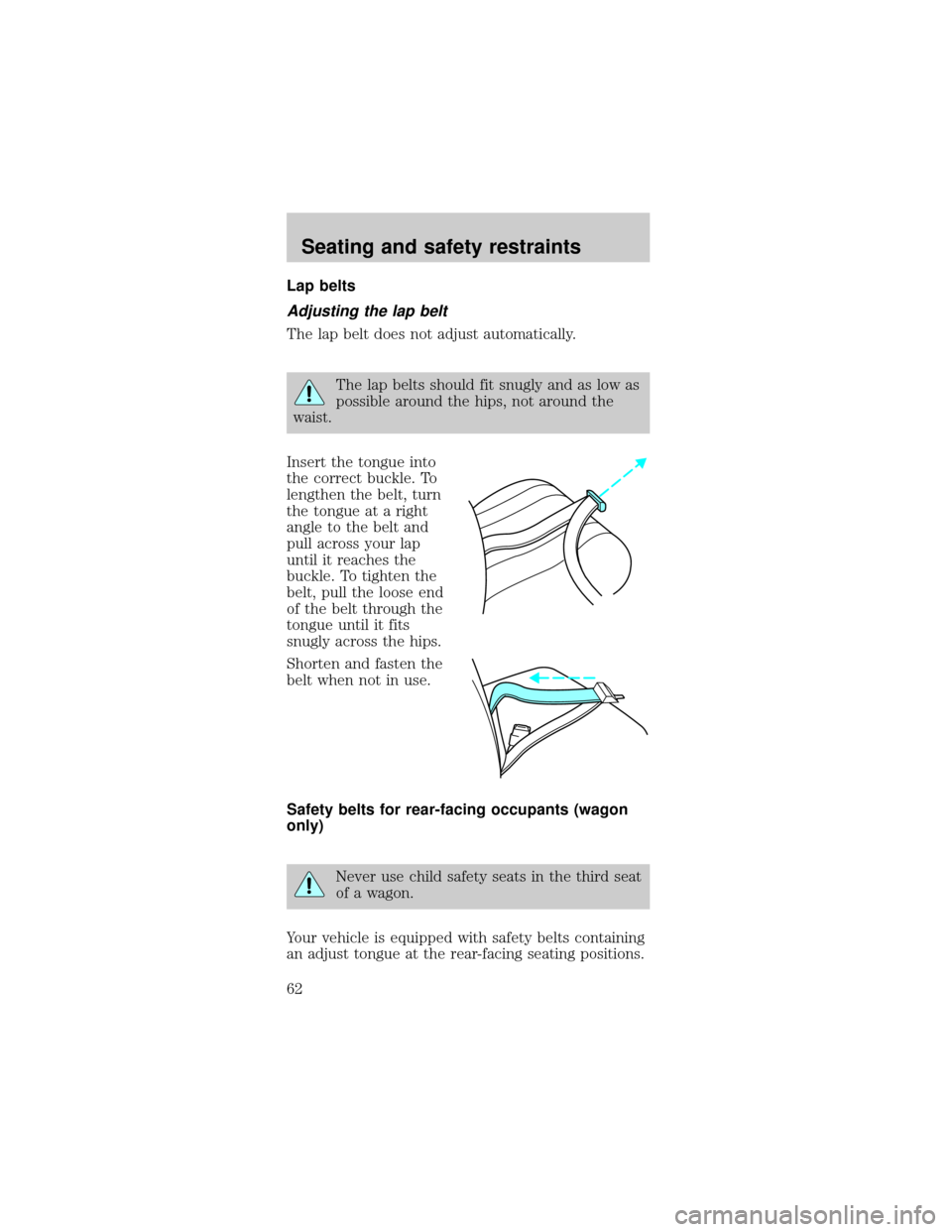length Mercury Sable 1998 Owner's Manuals
[x] Cancel search | Manufacturer: MERCURY, Model Year: 1998, Model line: Sable, Model: Mercury Sable 1998Pages: 190, PDF Size: 1.29 MB
Page 32 of 190

TURN SIGNAL CONTROL
²Push down to
activate the left turn
signal.
²Push up to activate
the right turn signal.
WINDSHIELD WIPER/WASHER CONTROLS
Rotate the windshield
wiper control to the
desired interval, low or
high speed position.
The bars of varying length are for intermittent
wipers. When in this position rotate the control
upward for fast intervals and downward for slow
intervals.
Push the control on
the end of the stalk to
activate washer. Push
and hold for a longer
wash cycle. The washer will automatically shut off
after ten seconds of continuous use.
Rear window wiper and washer (wagon only)
The rear wiper control
is located under the
headlamp controls
Press the wiper control
to activate the rear
wiper. Press again to
turn off the wiper.
LOF
OFFS
HI
LOF
OFFS
HI
Controls and features
32
Page 42 of 190

To prevent the possibility of injuries, the
fasteners for the cargo area cover must be
properly attached to the mounting clips on the
rear trim panels.
Do not place any objects on the cargo area
cover. They may obstruct your vision or
strike occupants of the vehicle in the case of a
sudden stop or collision.
Rewinding the shade
With extended use, the cargo shade may lose its
spring tension. If this occurs, the shade must be
manually rewound. This is a two-person operation.
1. Remove the shade from the vehicle and extend it
with the smooth grain facing you.
2. Wrap the vinyl
around the roller tube
twice. Tuck the edges
of the vinyl inside the
end cap with each
wrap.
3. Fold the edges of
the vinyl towards the
center, making sure that the edges clear the end cap
slots. Use tape or a rubber band to hold the vinyl to
the left side of the tube.
4. Push in the right
end cap (marked RH)
about ò of the total
length to disengage the
clutch and hold the
end cap in while
turning the roller tube
toward you 14 times.
Controls and features
42
Page 59 of 190

2. To unfasten, push
the release button and
remove the tongue
from the buckle.
The front and rear outboard safety restraints in the
vehicle are combination lap and shoulder belts. The
front and rear seat passenger outboard safety belts
have two types of locking modes described below:
Vehicle sensitive mode
The vehicle sensitive mode is the normal retractor
mode, allowing free shoulder belt length adjustment
to your movements and locking in response to
vehicle movement. For example, if the driver brakes
suddenly or turns a corner sharply, or the vehicle
receives an impact of 8 km/h (5 mph) or more, the
combination safety belts will lock to help reduce
forward movement of the driver and passengers.
Automatic locking mode
In this mode, the shoulder belt is automatically
pre-locked. The belt will still retract to remove any
slack in the shoulder belt.
The automatic locking mode is not available on the
driver safety belt.
When to use the automatic locking mode
²When a tight lap/shoulder fit is desired.
²Anytimea child safety seat is installed in the
vehicle. Refer toSafety Restraints for Children
orSafety Seats for Childrenlater in this chapter.
Seating and safety restraints
59
Page 62 of 190

Lap belts
Adjusting the lap belt
The lap belt does not adjust automatically.
The lap belts should fit snugly and as low as
possible around the hips, not around the
waist.
Insert the tongue into
the correct buckle. To
lengthen the belt, turn
the tongue at a right
angle to the belt and
pull across your lap
until it reaches the
buckle. To tighten the
belt, pull the loose end
of the belt through the
tongue until it fits
snugly across the hips.
Shorten and fasten the
belt when not in use.
Safety belts for rear-facing occupants (wagon
only)
Never use child safety seats in the third seat
of a wagon.
Your vehicle is equipped with safety belts containing
an adjust tongue at the rear-facing seating positions.
Seating and safety restraints
62
Page 63 of 190

When the adjust tongue of the lap/shoulder
combination seat belt is latched into the buckle, the
tongue will allow the lap portion to become shorter,
but locks the webbing in place to restrict it from
becoming longer.
Before you reach and latch a combination lap and
shoulder belt having an adjust tongue into the
buckle, you may have to lengthen the lap belt
portion of it. To lengthen the lap belt, pull some
webbing out of the shoulder belt retractor. While
holding the webbing below the tongue, grasp the
tongue so that it is parallel to the webbing and slide
the tongue upward. Provide enough length so that
the tongue can reach the buckle.
To fasten the belt, pull the combination lap and
shoulder belt from the retractor so that the shoulder
belt portion of the safety belt crosses your shoulder
and chest. Be sure the belt is not twisted. If the belt
is twisted, remove the twist. Insert the tongue into
the proper buckle for your seating position until you
hear a snap and feel it latch. Make sure the tongue
is securely fastened to the buckle by pulling on the
tongue.
The lap belts should fit snugly and as low as
possible around the hips, not around the
waist.
Front and rear seat occupants, including
pregnant women, should wear safety belts
for optimum protection in an accident.
Seating and safety restraints
63
Page 78 of 190

10. Try to pull the belt out of the retractor to make
sure the retractor is in the automatic locking mode
(you should not be able to pull more belt out). If the
retractor is not locked, unbuckle the belt and repeat
steps two through nine.
Check to make sure the child seat is properly
secured before each use.
Installing a child safety seat in the center rear
seating position with adjustable lap belt
1. Lengthen the lap belt. To lengthen the belt, hold
the tongue so that its bottom is perpendicular to the
direction of webbing while sliding the tongue up the
webbing.
2. Place the child safety seat in the center seating
position.
3. Route the tongue and webbing through the child
seat according to the child seat manufacturer's
instructions.
4. Insert the belt tongue into the proper buckle for
the center seating position until you hear a snap and
feel it latch. Make sure the tongue is securely
fastened to the buckle by pulling on tongue.
5. Push down on the child seat while pulling on the
loose end of the lap belt webbing to tighten the belt.
6. Before placing the child into the child seat,
forcibly tilt the child seat from side to side and in
forward direction to make sure that the seat is held
securely in place. If the child seat moves excessively,
repeat steps 5 through 6, or properly install the
child seat in a different position.
Attaching safety seats with tether straps
Some manufacturers make safety seats that include
a tether strap that goes over the back of the vehicle
seat and attaches to an anchoring point. Other
manufacturers offer the tether strap as an accessory.
Contact the manufacturer of your child safety seat
for information about ordering a tether strap.
Seating and safety restraints
78
Page 97 of 190

N (Neutral)
With the gearshift in
the N (Neutral)
position, the vehicle
can be started and is
free to roll. Hold the
brake pedal down
while in this position.
(Overdrive Ð column shift without O/D OFF
switch) or D (Overdrive Ð column or console
mounted gearshift with O/D off switch)
The overdrive position
is the normal driving
position for an
automatic overdrive
transaxle. It works the
same way as
(Overdrive) or D
(Drive Ð with the O/D
OFF switchnot
depressed) works, but
shifts to a fourth gear
Ð an overdrive gear Ð
when your vehicle
cruises at a constant speed for any length of time.
This fourth gear will increase your fuel economy
when you travel at cruising speeds.
Overdrive may not be appropriate for certain
terrains. If the transaxle shifts back and forth
between third and fourth gears while you are driving
hilly roads or if your vehicle requires additional
power for climbing hills, shift into D (Drive) or press
the O/D OFF switch (if equipped).
Driving
97
Page 177 of 190

ENGINE DATA
Engine 3.0L V6 Vulcan
engine3.0L V6
Duratec
engine
Cubic inches 182 181
Horsepower 145 @ 5250
rpm200 @ 5750
rpm
Torque 170 lb.-ft. @
3250 rpm200 lb.-ft. @
4500 rpm
Recommended
fuel87 octane 87 octane
Firing order 1-4-2-5-3-6 1-4-2-5-3-6
Spark plug gap 1.07-1.17 mm
(0.042-0.046
inch)1.3-1.4 mm
(0.052-00.056
inch)
Ignition system EDIS EDIS
Compression
ratio9.3:1 10:1
VEHICLE DIMENSIONS
Vehicle
dimensionsSedan mm
(in)Wagon mm (in)
(1) Overall
length5 016.5
(197.5)5 069.8 (199.6)
(2) Overall
width1 854.2 (73.0) 1 854.2 (73.0)
(3) Overall
height1 399.5 (55.1) 1 463.0 (57.6)
(4) Wheelbase 2 755.9
(108.5)2 755.9 (108.5)
(5) Track -
Front1 564.6 (61.6) 1 564.6 (61.6)
(5) Track -
Rear1 559.6 (61.4) 1 569.7 (61.8)
Capacities and specifications
177